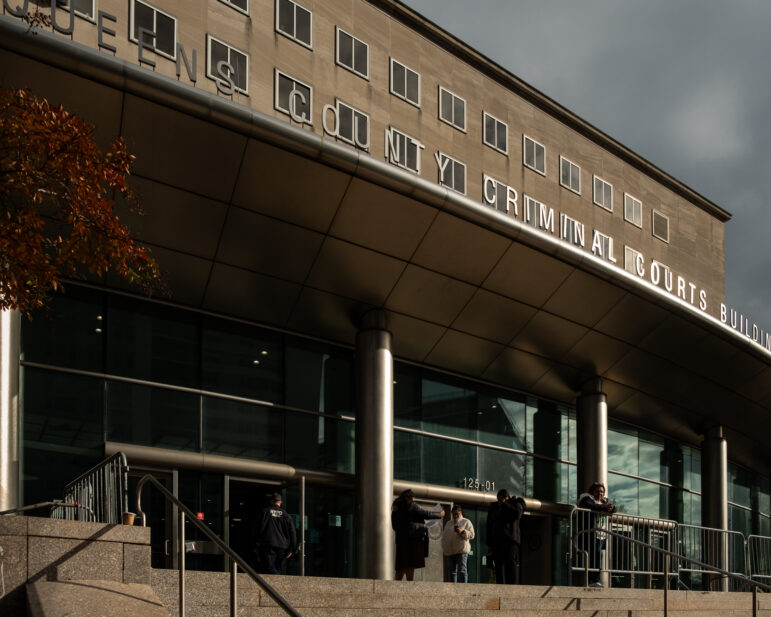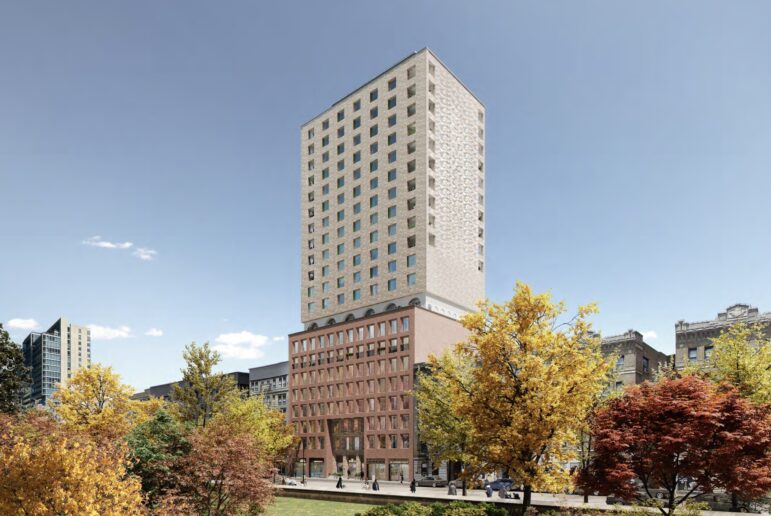It’s an old idea enjoying a renaissance this summer: block off a street to cars, and let people take over. Last Sunday in Jackson Heights, kids ventured out of Travers Park into adjacent 78th Street – normally a busy throughway between Northern Boulevard and Roosevelt Avenue – weaving their bikes through the new territory and leaving painted handprints on the crosswalk. Later in the day, after most people had retreated from the heat, local resident Frances Temple-West strolled the quiet street with her two daughters. “I use this park every day. I was here twice already,” she said. “The street closing is great.”
78th St. Summer Sundays, which will continue through November, may help alleviate Jackson Heights’ two-tiered standard of green living. While residents of the historic garden apartments have spacious private gardens, everyone else crowds into a Travers Park, a condensed version of an already dense neighborhood. On the blacktop, kids dart between players of cricket, baseball and soccer, while parents pack the shady benches. Teenagers hang out by the handball courts; seniors rest under the trees. To top it off, the Sunday greenmarket renders a nearby sidewalk all but impassable.
And that’s about all the neighborhood has for parks: In a 2005 ranking by New Yorkers for Parks, an advocacy group, Jackson Heights placed 50 out of 51 city council districts for park acres per person (number 51, district 4 on the Upper East Side, has the least park space but also borders Central Park). The arrival of young families from other countries and, increasingly, other boroughs, has created a growing demand for kid space; last year a group of local parents formed the group JH Green to improve Travers Park. They pursued the idea of buying out an adjacent Toyota dealership lot to expand the green, but the owners weren’t interested in selling. Early this year, after JH Green banded with the Western Jackson Heights Alliance and the Jackson Heights Beautification Group, the idea to close 78th Street emerged.
Jackson Heights’ grassroots park expansion begins as City Hall is taking a more experimental approach to the reappropriation of space for driving and recreation. On the day the final permits for the 78th Street closing came through, Mayor Bloomberg announced the creation of Broadway Boulevard, a permanent pedestrian strip that will occupy two lanes between Times Square and 34th Street. Another high-profile, though temporary, closing will stretch from Brooklyn Bridge to 72nd Street for three consecutive Saturdays this August. And in Brooklyn, parts of Montague and Bedford Avenues will be closed to cars for the first time this summer, with activities sponsored by local businesses.
“New Yorkers have soured on traditional street fair closings with outside vendors selling tube socks and funnel cake,” says Wiley Norvell of Transportation Alternatives (making an observation echoing this report on street fairs by the Center for an Urban Future, City Limits’ sister policy institute), which assisted the Travers Park activists. “What people want is the pleasure of walking their own streets.” The new transportation planning emphasizes flexibility: a single street can sometimes serve cars, and other times pedestrians and bikers.
~
Though the mayor cites London, Paris and Bogotá as models for the new “Summer Streets,” New York has its own history of turning roadways into temporary open space. The Police Athletic League began sponsoring play streets in 1914, and still runs 113 such sites, about 30 of which involve street closings. On Earth Day 1970, Mayor John Lindsay launched a major street closing on Fifth Avenue between 14th and 59th Streets. The popular Fifth Avenue closing became a Sunday tradition, but that baby that was thrown out with the bathwater of 1970’s malaise. The Bronx’s Grand Concourse had a busy Sunday pedestrian area until Mayor Rudy Giuliani shut it down in 1996.
The resurgence of political support for street closings has much to do with PlaNYC, the mayor’s blueprint for city development through 2030. The plan emphasizes the importance of green open spaces, and proposes that there be a park within a 10-minute walk of every resident. In Western Queens, where the window to secure open parkland has been shut since the days of Robert Moses, street closings may be the most effective way to bring open, if not exactly green, space to a growing population.
Late in the day on July 20, Will Sweeney was sweeping up a patch of shattered glass on 78th Street as kids biked around him. Sweeney, a film producer, founded the Western Jackson Heights Alliance to address traffic congestion; he also helped shepherd the play street closing idea through the DOT, local community board and police department. “Jackson Heights is a great neighborhood, but we need more places for people to gather,” he said. “If 70 percent of people here don’t drive, is it right that so much public space is for storing cars?” As if to illustrate his point, a black cab rolled by; someone had ignored the street closing signs and moved aside the barricade.
Still, Sweeney says, he has received only two complaints over lost parking space – compared to words of support from “hundreds” of park goers. As evening sets in, children gather their artwork and volunteers scrub wayward blobs of paint from the street. A boy makes one final round on his scooter. 78th Street seems to have won a new role in the life of the surrounding community.







